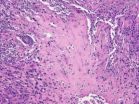(Press-News.org) Biomolecular imaging can reveal a great deal of information about the inner workings of cells and one of the most attractive targets for imaging are glycans – sugars that are ubiquitous to living organisms and abundant on cell surfaces. Imaging a glycan requires that it be tagged or labeled. One of the best techniques for doing this is a technique called click chemistry. The original version of click chemistry could only be used on cells in vitro, not in living organisms, because the technique involved catalysis with copper, which is toxic at high micromolar concentrations. A copper-free version of click chemistry that can safely be used in living organisms is available, but it is not always optimal in terms of reaction kinetics and target specificity. Now, a variation of click chemistry has been introduced that retains the copper catalyst of the original reaction - along with its speed and specificity – but is safe for cells in vivo.
Researchers with the Lawrence Berkeley National Laboratory (Berkeley Lab), in collaboration with researchers at the Albert Einstein College of Medicine at Yeshiva University in New York, have found a way to make copper-catalyzed click chemistry biocompatible. By adding a ligand that minimizes the toxicity of copper but still allows it to catalyze the click chemistry reaction, the researchers can safely use their reaction in living organisms. Compared to the copper-free click chemistry reaction, which can take up to an hour, the ligand-accelerated copper-catalyzed click chemistry reaction can achieve effective labeling within 3-5 minutes. The presence of the copper catalyst also enables this new formulation of click chemistry to be more target-specific with fewer background side reactions.
"The discovery of this new accelerating ligand for copper-catalyzed click chemistry should provide an effective complimentary tool to copper-free click chemistry," says Yi Liu, a chemist with Berkeley Lab's Molecular Foundry and the co-leader of this research with Peng Wu, of the Albert Einstein College of Medicine.
"While copper-free click chemistry may have advantages for whole animal imaging experiments such as imaging in mice," Liu says, "our ligand-accelerated copper reaction is better suited for enriching glycoproteins for their identification."
The ligand-accelerated copper-catalyzed reaction was used to label glycans in recombinant glycoproteins, glycoproteins in cell lysates, glycoproteins on live cell surfaces, and glycoconjugates in live zebrafish embryos. Because a zebrafish embryo is transparent in the first 24 hours of its development, it allows labeled glycans to be detected via molecular imaging techniques, making it a highly useful model for developmental biology studies.
"Based on our results," says Peng Wu, "we believe that ligand-accelerated copper-catalyzed click chemistry represents a powerful and highly adaptive bioconjugation tool that holds great promise for further improvement with the discovery of more versatile catalyst systems."
Click chemistry, which was introduced in 2002 by the Nobel laureate chemist Barry Sharpless of the Scripps Research Institute, utilizes a copper-catalyzed azide-alkyne cycloaddition (CuAAC) reaction that makes it possible for certain chemical building blocks to "click" together in an irreversible linkage, analogous to the snapping together of Lego blocks. While the technique immediately proved valuable for attaching small molecular probes to various biomolecules in a test tube or on fixed cells, it could not be used for biomolecule labeling in live cells or organisms because of the copper catalyst.
In 2007, Carolyn Bertozzi, a chemist who holds joint appointments with Berkeley Lab, the University of California (UC) Berkeley, and the Howard Hughes Medical Institute, led a research effort that produced a copper-free version of click chemistry. In this version, glycans were metabolically labeled with azides - a functional group featuring three nitrogen atoms - via reactions that were carried out through the use of cyclooctyne reagents that required no copper catalyst. With their latest reagent, biarylazacyclooctynone (BARAC), Bertozzi and her group have provided a copper-free click chemistry technique that delivers relatively fast reaction kinetics and the bioorthogonality needed for biomolecule labeling. However, the technique can only be used on biomolecules that can be tagged with azides.
"Our bio-benign ligand-accelerated copper-catalyzed click chemistry reaction liberates bioconjugation from the limitation where ligations could only be accomplished with azide-tagged biomolecules," Liu says. "Now terminal alkyne residues can also be incorporated into biomolecules and detected in vivo."
INFORMATION:
The latest paper on this research appears in the journal Angewandte Chemie, titled "Raising the Efficacy of Bioorthogonal Click Reactions for Bioconjugation: A Comparative Study." Co-authoring the paper with Liu and Wu were Christen Besanceney-Webler, Hao Jiang, Tianqing Zheng, Lei Feng, David Soriano del Amo, Wei Wang, Liana Klivansky and Florence Marlow.
This work was supported by a grant from the National Institutes of Health, and in part as a User Project at the Molecular Foundry, which is funded through DOE's Office of Science.
The Molecular Foundry is one of the five DOE Nanoscale Science Research Centers (NSRCs), premier national user facilities for interdisciplinary research at the nanoscale. Together the NSRCs comprise a suite of complementary facilities that provide researchers with state-of-the-art capabilities to fabricate, process, characterize and model nanoscale materials, and constitute the largest infrastructure investment of the National Nanotechnology Initiative. The NSRCs are located at DOE's Argonne, Brookhaven, Lawrence Berkeley, Oak Ridge and Sandia and Los Alamos National Laboratories. For more information about the DOE NSRCs, please visit http://nano.energy.gov.
Lawrence Berkeley National Laboratory addresses the world's most urgent scientific challenges by advancing sustainable energy, protecting human health, creating new materials, and revealing the origin and fate of the universe. Founded in 1931, Berkeley Lab's scientific expertise has been recognized with 12 Nobel prizes. The University of California manages Berkeley Lab for the U.S. Department of Energy's Office of Science. For more, visit www.lbl.gov.
Click chemistry with copper -- a biocompatible version
Scientists with Berkeley Lab and Einstein College of Medicine extend conventional click chemistry to living cells
2011-07-19
ELSE PRESS RELEASES FROM THIS DATE:
Cancer stem cells recruit normal stem cells to fuel ovarian cancer, U-M study finds
2011-07-19
ANN ARBOR, Mich. — Researchers at the University of Michigan Comprehensive Cancer Center have found that a type of normal stem cell fuels ovarian cancer by encouraging cancer stem cells to grow.
Cancer stem cells are the small number of cells in a tumor that drive its growth and spread. Traditional cancer treatments do not kill these cells, which is why cancer treatments often fail.
In a study published online in the Journal of Clinical Investigation, researchers looked in ovarian tissue at the mesenchymal stem cells, which are normal cells found throughout the body. ...
New therapy provides hope for millions of people suffering from bowel incontinence
2011-07-19
CHICAGO- A new procedure is now available for the treatment of chronic bowel incontinence, a disorder impacting the lives of more than 18 million Americans. The treatment, called InterStim® Therapy is a minimally invasive procedure which uses electrical impulses to stimulate the sacral nerve and improve muscle function. It is one of the only effective long-term treatments for bowel incontinence available to patients and Northwestern Memorial Hospital is one of the first medical centers in the country to offer the procedure.
"Bowel control problems can have a significant, ...
Research identifies genes vital to preventing childhood leukemia
2011-07-19
Researchers at The University of Western Ontario have identified genes that may be important for preventing childhood leukemia. Acute lymphoblastic leukemia (ALL) is a cancer of the blood that occurs primarily in young children. It's frequently associated with mutations or chromosomal abnormalities that arise during embryonic or fetal development. Working with mice, researchers led by Rodney DeKoter identified two key genes that appear essential in the prevention of B cell ALL, the most common form of ALL in children. The study is published online in Blood, the Journal ...
Grand Cayman blue iguana: Back from the brink of extinction
2011-07-19
While thousands of species are threatened with extinction around the globe, efforts to save the Grand Cayman blue iguana represent a rarity in conservation: a chance for complete recovery, according to health experts from the Wildlife Conservation Society's Bronx Zoo and other members of the Blue Iguana Recovery Program.
Coordinated by the National Trust for the Cayman Islands, the Blue Iguana Recovery Program—a consortium of local and international partners—has successfully released more than 500 captive-bred reptiles since the initiative's inception in 2002, when the ...
Preschool-age kids in different countries improve academically using self-regulation game
2011-07-19
Children who regularly participated in a Simon Says-type game designed to improve self-regulation – called the Head-Toes-Knees-Shoulders task – may have better math and early literacy scores.
The study found that the higher academic outcomes associated with the game, which emphasizes careful listening and following instructions, does not just benefit students in the United States, but also benefits children tested in Taiwan, China and South Korea.
More than 800 preschool age children ages 3-6 years old in the four countries participated in the study, which was just ...
IADR/AADR publish study on use of Twitter for public health surveillance of dental pain
2011-07-19
Alexandria, VA, USA – The microblogging service Twitter is a new means for the public to communicate health concerns and could afford health care professionals new ways to communicate with patients. With the growing ubiquity of user-generated online content via social networking Web sites such as Twitter, it is clear we are experiencing a revolution in communication and information sharing. In a study titled "Public Health Surveillance of Dental Pain via Twitter," published in the Journal of Dental Research—the official publication of the International and American Associations ...
Solar Panels Keep Buildings Cool
2011-07-19
Those solar panels on top of your roof aren't just providing clean power; they are cooling your house, or your workplace, too, according to a team of researchers led by Jan Kleissl, a professor of environmental engineering at the UC San Diego Jacobs School of Engineering.
In a study in an upcoming issue of the journal Solar Energy, Kleissl and his team published what they believe are the first peer-reviewed measurements of the cooling benefits provided by solar photovoltaic panels. Using thermal imaging, researchers determined that during the day, a building's ceiling ...
New grant supports Hastings work on ethics of medical research with animals
2011-07-19
(Garrison, NY) The Esther A. and Joseph Klingenstein Fund awarded The Hastings Center a $159,000 grant to explore the ethical, scientific, and legal issues on using animals in medical research and on the prospects for using alternatives to animal models.
The project comes at a time when arguments about animal experimentation are changing in fundamental and profound ways. Scientific journals and some biomedical researchers are calling for increased public engagement and education about animal research. The longstanding view that one is either pro-medical progress or pro-animal ...
8-question survey can help predict post-traumatic stress disorder
2011-07-19
A simple eight-question survey administered soon after injury can help predict which of the 30 million Americans seeking hospital treatment for injuries each year may develop depression or post-traumatic stress, report Therese S. Richmond, PhD, CRNP, associate professor at the University of Pennsylvania School of Nursing, and her colleagues in General Hospital Psychiatry.
"Depression and PTSD exert a significant, independent, and persistent effect on general health, work status, somatic symptoms, adjustment to illness, and function after injury," the authors wrote, also ...
Chloroquine finding may lead to treatments for arthritis, cancer and other diseases
2011-07-19
In a study published recently in the journal Science Signaling Van Andel Research Institute (VARI) scientists demonstrate on the molecular level how the anti-malaria drug chloroquine represses inflammation, which may provide a blueprint for new strategies for treating inflammation and a multitude of autoimmune diseases such as arthritis, multiple sclerosis, and certain cancers.
Chloroquine is a widely used anti-malaria drug that inhibits the growth of parasites. For decades, chloroquine and its derivative amodiaquine have also been used as anti-inflammation drugs to treat ...
LAST 30 PRESS RELEASES:
New critique prompts correction of high-profile Yellowstone aspen study, highlighting challenges in measuring ecosystem response to wolf reintroduction
Stroke survivors miss critical treatment, face greater disability due to systemic transfer delays
Delayed stroke care linked to increased disability risk
Long term use of anti-acid drugs may not increase stomach cancer risk
Non-monetary 'honor-based' incentives linked to increased blood donations
Natural ovulation as effective as hormones before IVF embryo transfer
Major clinical trial provides definitive evidence of impacts of steroid treatment on severe brain infection
Low vitamin D levels shown to raise risk of hospitalization with potentially fatal respiratory tract infections by 33%
Diagnoses of major conditions failing to recover since the pandemic
Scientists solve 66 million-year-old mystery of how Earth’s greenhouse age ended
Red light therapy shows promise for protecting football players’ brains
Trees — not grass and other greenery — associated with lower heart disease risk in cities
Chemical Insights scientist receives Achievement Award from the Society of Toxicology
Breakthrough organic crystalline material repairs itself in extreme cold temperatures, unlocking new possibilities for space and deep-sea technologies
Scientists discover novel immune ‘traffic controller’ hijacked by virus
When tropical oceans were oxygen oases
Positive interactions dominate among marine microbes, six-year study reveals
Safeguarding the Winter Olympics-Paralympics against climate change
Most would recommend RSV immunizations for older and pregnant people
Donated blood has a shelf life. A new test tracks how it's aging
Stroke during pregnancy, postpartum associated with more illness, job status later
American Meteorological Society announces new executive director
People with “binge-watching addiction” are more likely to be lonely
Wild potato follows a path to domestication in the American Southwest
General climate advocacy ad campaign received more public engagement compared to more-tailored ad campaign promoting sustainable fashion
Medical LLMs may show real-world potential in identifying individuals with major depressive disorder using WhatsApp voice note recordings
Early translational study supports the role of high-dose inhaled nitric oxide as a potential antimicrobial therapy
AI can predict preemies’ path, Stanford Medicine-led study shows
A wild potato that changed the story of agriculture in the American Southwest
Cancer’s super-enhancers may set the map for DNA breaks and repair: A key clue to why tumors become aggressive and genetically unstable
[Press-News.org] Click chemistry with copper -- a biocompatible versionScientists with Berkeley Lab and Einstein College of Medicine extend conventional click chemistry to living cells




